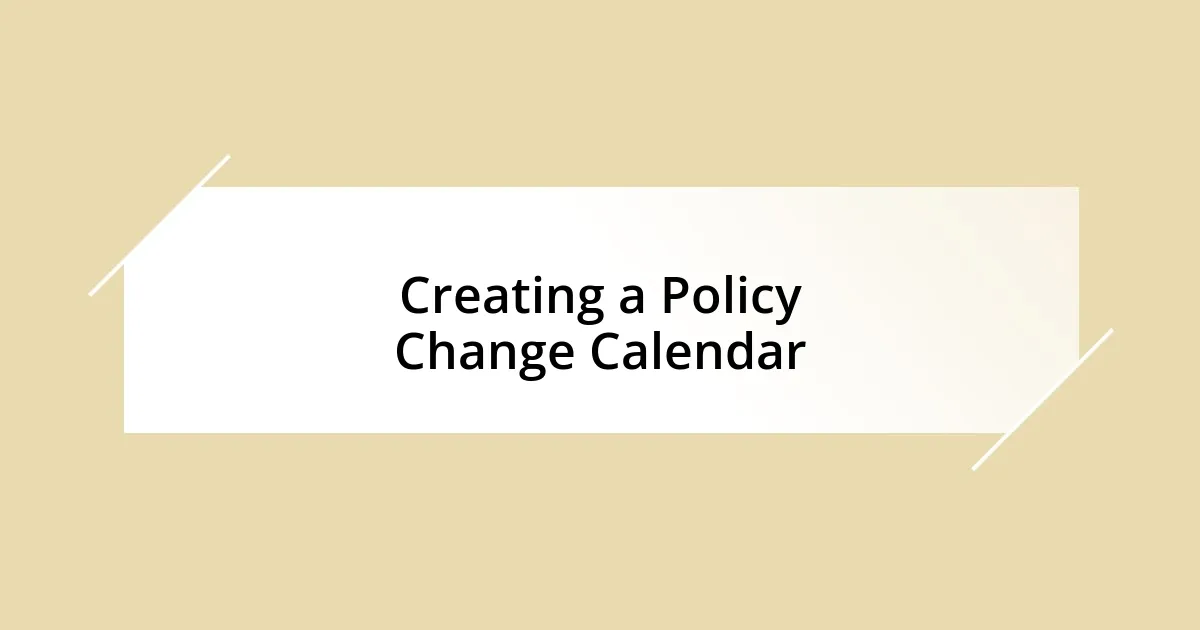Key takeaways:
- Understanding policy changes is crucial as they have significant implications for individuals and communities.
- Effective tracking requires using diverse sources, tools, and organizing strategies to stay informed and engaged.
- Regular analysis of policy impacts involves collaboration and can reveal unintended consequences, enriching overall understanding.
- Clear communication with stakeholders fosters engagement and feedback, making the policy process a collaborative effort.

Understanding Policy Change Importance
Understanding the importance of policy change is not just an academic exercise; it has real-world implications that affect our daily lives. I remember a time when a sudden change in healthcare policy left many in my community confused and anxious about their coverage. How often do we pause to consider how a single policy shift can ripple through our lives?
Reflecting on my experiences, I’ve observed that policy changes can shape the landscape of entire industries—think about how environmental regulations are evolving. I once worked with a company that had to pivot dramatically due to new sustainability policies. This shift wasn’t just a bureaucratic hurdle; it was a chance for innovation and growth, but it also came with uncertainty. Have you ever felt that mix of excitement and apprehension when facing a new policy?
The personal stakes in understanding policy changes can be profound. When legislation changes, it affects not just large institutions but families and individuals too. I often find myself asking: How does this policy change impact the people I care about? Delving deeper into these shifts allows me to stay informed and proactive, rather than merely reactive.

Identifying Key Policy Sources
Identifying the right sources for policy changes is crucial. I often start by following government websites and official publications to get the most accurate updates. I remember when I stumbled upon a new education policy announcement through an official newsletter; it offered deeper insights than any news article.
Another valuable source can be advocacy groups and think tanks. These organizations often analyze policies and provide context that can be easily overlooked. For instance, I participated in a workshop hosted by a nonprofit focused on social justice, where they explained the nuances of legislative changes affecting local communities. This experience completely opened my eyes to perspectives I hadn’t considered before.
Lastly, connecting with local community organizations helps me gather grassroots insights. I once attended a town hall meeting where residents shared their experiences with a recent zoning policy shift. Hearing their stories and concerns made it clear just how interconnected policy decisions are to our everyday lives. Engaging with varied sources ensures that my understanding of policy changes is comprehensive and well-rounded.
| Policy Source | Benefits |
|---|---|
| Government Websites | Accurate and official updates |
| Advocacy Groups | Contextual analysis and advocacy |
| Local Community Organizations | Grassroots insights and direct impact |

Setting Up Tracking Tools
Setting up tracking tools is a pivotal step in effectively monitoring policy changes. I’ve realized that investing time in selecting the right tools pays off significantly in the long run. During my early days of tracking, I relied solely on bookmarks in my browser; it felt overwhelming and chaotic. Transitioning to dedicated tools transformed my experience, creating a more streamlined process for managing updates.
Here’s a quick list of tools I’ve found incredibly helpful:
- RSS Feeds: I use these to receive real-time updates from my favorite policy sites. It keeps me in the loop without searching continuously.
- Public Tracking Apps: Utilizing apps specifically designed to monitor policy changes allows for customized alerts, so I only get notified about the topics that matter to me.
- Collaborative Software: Platforms like Google Docs enable me to share notes and updates with colleagues, sparking discussions that deepen our understanding of the implications behind changes.
Having these tools in place has not only organized my approach but has also alleviated much of the uncertainty that used to accompany policy shifts. I remember the sense of control I felt when I first set up my alerts—the overwhelm shifted to clarity, allowing me to focus on analysis rather than just tracking.

Creating a Policy Change Calendar
Creating a policy change calendar can be a game changer for staying organized. Personally, I find that mapping out key dates helps me visualize the timeline of changes. I remember the sense of accomplishment I felt when I plotted deadlines for public comment periods on my calendar; it was like having a personal road map for navigating complex policy landscapes.
In my experience, I like to mark not only the implementation dates but also the opportunities for public input and community meetings. For instance, last year I engaged deeply with a housing reform initiative because I had noted all the related events in my calendar. This proactive approach allowed me to participate meaningfully and contribute my insights, which felt incredibly empowering.
To make the calendar effective, I recommend using color codes—for instance, one color for legislative sessions and another for advocacy events. This visual cue makes it easier to identify upcoming priorities at a glance. I’ve often thought, “How can I fully engage if I’m constantly scrambling?” The answer lies in preparation—having a well-organized calendar has enabled me to stay focused and engaged, turning potential chaos into a structured plan of action.

Analyzing Policy Impact Regularly
Analyzing the impact of policy changes regularly is essential for understanding their real-world effects. I’ve found that taking the time to review and assess these changes every few months really helps in grasping how they affect my community and the broader landscape. I often ask myself, “What’s actually shifted?”—a question that drives me to dive deep into the data and discussions surrounding these policies.
In my experience, involving stakeholders in the analysis process can yield surprising insights. I remember during a quarterly review of education policy changes, my colleagues and I unearthed unintended consequences that had surfaced after implementation. This collaborative approach not only enriched our understanding but also highlighted how diverse perspectives can illuminate blind spots—it’s a reminder that we’re all part of a larger conversation.
Set aside dedicated time for analysis, much like you would for any important meeting. I like to create a summary report after each analysis session; it serves as both a reference and a reflection of my evolving understanding. The satisfaction I feel when I connect the dots between policy intentions and actual impacts is exhilarating. It makes the tracking process feel more purposeful, and I constantly strive to better understand how these policies shape the world around us.

Communicating Changes with Stakeholders
When it comes to communicating changes with stakeholders, clarity is absolutely key. I’ve learned that crafting transparent messages allows everyone involved to understand the implications of policy adjustments. For example, during a recent health policy shift, I made it a point to hold an informal coffee chat with local community leaders to discuss the changes. The connection I felt during that conversation emphasized how critical it is to create open lines of communication.
I often utilize visual aids, like infographics, when relaying information to stakeholders. Last summer, I designed an infographic that simplified complex regulatory details, and it sparked immediate interest and discussion among community members. In moments like these, I find myself questioning, “How can I make this information resonate?” The answer lies in presenting the data in a way that’s engaging and digestible.
Additionally, actively listening to stakeholder feedback during these discussions has proven invaluable. I recall one instance where initial resistance to a policy change turned into constructive dialogue because I made space for their concerns. By fostering an environment where everyone feels heard, we can navigate changes collaboratively, which ultimately cultivates a sense of shared ownership. This experience reinforced my belief that change isn’t just communicated; it’s a conversation that thrives on mutual respect and understanding.

Adapting Strategies Based on Changes
Adapting strategies based on changes is a dynamic process that requires constant vigilance and flexibility. I often find myself reassessing my approaches whenever new policies roll out. For instance, after a recent environmental regulation was introduced, I quickly realized that my previous methods for tracking compliance were outdated. This prompted me to develop a more agile framework that factored in real-time data and feedback—it’s amazing how much more effective I feel when I can pivot efficiently!
I’ve also experienced firsthand the value of fostering a culture of adaptability within my team. I recall an intense week when sudden healthcare policy amendments caused our original project plans to shift dramatically. Instead of panicking, we huddled together to brainstorm alternative strategies, leveraging each person’s insights to build a robust response in a short time. The team’s camaraderie grew through this challenge, proving that adaptability isn’t just about adjusting plans; it’s about strengthening relationships and collaboration along the way.
It’s crucial to ask yourself, “What’s the best way to move forward?” This question pushes me to not only evaluate current strategies but also to engage with ongoing learning opportunities. I recently enrolled in a workshop that focused on strategic pivoting, and it unveiled some innovative techniques that I hadn’t considered before. Staying open to new ideas has always helped me refine my approaches, ultimately ensuring that I’m not just reacting to changes but proactively shaping my strategies for success.














